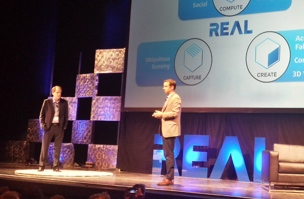I spent last week at the inaugural edition of the new conference for Autodesk’s Reality Capture division; REAL2015. I’ve already fielded several calls from friends and coworkers wanting to know what I thought about the show so I thought I’d start with the questions everyone has been asking.
- What was it all about? I think the best description would be that it showcased the work of those that are making things (mostly physical in nature) and those that are taking physical things and digitizing them. The common component between them being that Autodesk software is used in between these two ends of the workflow.
- Who was there? Some of the known participants from SPAR (ClearEdge3D, Dot Product, Kubit, Leica, LFM, P3dSystems, Topcon, etc.) Some of the AU exhibitors (HP, Intel, Otherlab, Thinkbox, etc.) Lastly, a few from the art world and some interesting startups with accessories for the reality capture market.
- Was it worth it? For me the answer is an unequivocal, “Yes!” However, it was for reasons that caught me a bit off guard.
First of all I saw a few products and presentations that were remarkably similar to demos, proofs of concept, and presentations that I gave 3-5 years ago. My initial reaction was a bit negative but the more I thought about it I came to the realization that A) at least the idea was a good one, B) they definitely took it further than I did, and C) we arrived at the same solution from different problems in different industries. I’ve been working with spatial data in some form for a while now. At one time I was strictly a service provider and as such billable hours was king. It was one of the reasons I loved going to conferences where I could indulge in other types of scanning and listen to people that were really pushing the envelope as opposed to working the efficiency to better billable track that I was living on a daily basis. Later, SmartGeoMetrics acquired my company and keeping up with all that one can see at SPAR became my job. It took more than a year, but eventually I was able to stay up with everything to the degree that those out of the blue applications became rare again.
What REAL2015 showed me was that I needed to go back to the mindset I had when I was waiting for Joe LaFranca to ship me our first scanner, the mindset that tried to use this new tool on EVERYTHING! What I realized is that I no longer think that way, now it is modified with terms like “cost-effective”, “commodity based,” & “consumption economics”. All good ideas that one must keep in mind, but all limiting factors to true innovation.
Quite a few of the presenters were in industries that have very different business models than the engineering/construction/architecture models that have driven a lot of the development in 3D imaging to date. Industries like fashion-design, film VFX, Bio-Engineering, Fine Art curation, and so on. As a result, these professionals had incentives to try very different things while solving very different problems from my own; all while using a lot of the same hardware and software that I use on a daily basis. I found the end result to be very inspiring. In fact, I’d argue that this inspiration, a re-charging of my professional batteries was my greatest initial take-away from the conference.
I say, “initial” because getting to make direct contact with these individuals may in the long term prove to be of far greater benefit. The people showcased were not in the 3D industry for its own sake but found themselves using it to propel their own chosen professions. Once again, this focus shift from my day to day was profound. Best of all, because it all comes down to X,Y & Z their ideas can be cross pollinated to form entirely new breeds of data capture, data analysis, and deliverable creation – or Capture, Compute, Create to use Autodesk’s marketing lingo.
Lastly, I enjoyed the DIY spirit that permeated the entire event from watching a software group put on a conference to many presenters who were only able to create their desired deliverable by creating many of their own tools along the way. From Saul Griffith of Otherlab who not only worked to create the Care Cube for isolating Ebola patients but a plastic welding and cutting machine so they could be produced as needed to Tim Webber of Framestore who helped create the movie “Gravity” by creating entirely new ways of filming using LED screens and robots in ways that you really have to see to believe. They filmed all of the presentations and I certainly hope that they make them available as I couldn’t attend every presentation and I’m sure that I missed some details from the ones that I attended. I can’t say that I returned with 200 new business cards and 30 qualified leads but I can defiantly say that I came back ready to go to work; and some days that seems harder to find than new leads.






